Hai să socializăm!
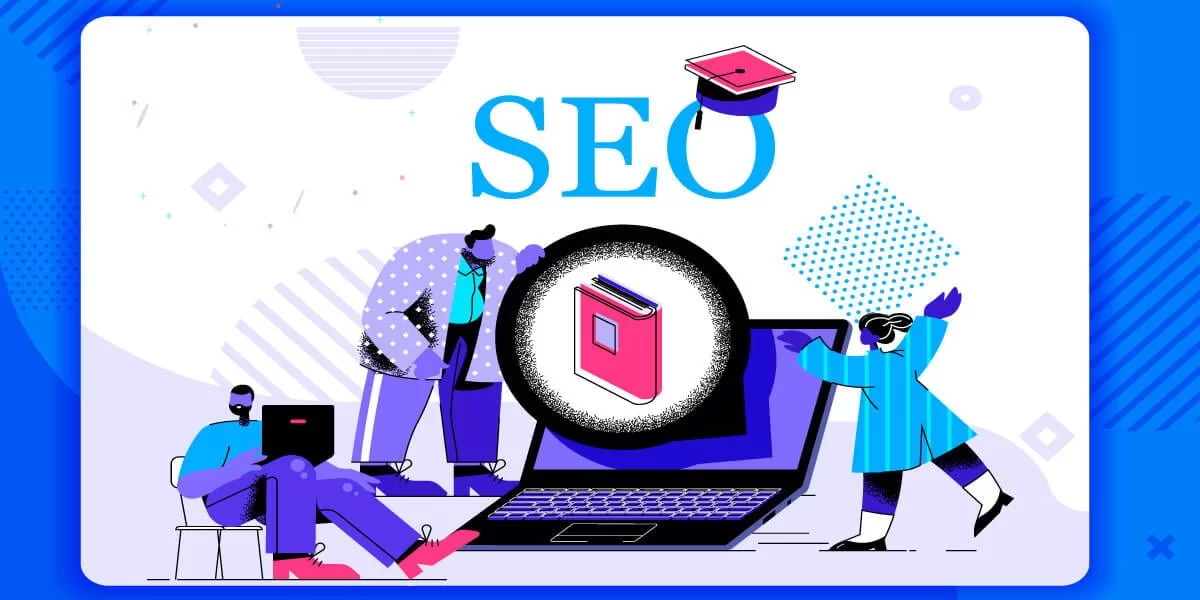
Learn SEO in 2020: A Complete Guide For SEO Begginners
This guide is aimed at both beginners who want to learn SEO and business owners who want to improve their visibility in search engines such as Google.
About this guide
This guide is aimed at both beginners who want to learn SEO and business owners who want to improve their visibility in search engines such as Google.
This SEO guide for beginners for 2020 will take you through the best SEO practices and tactics that will help you develop a solid strategy and attract organic traffic to your site.
That being said, let’s dive in…
SEO Basis

What is SEO?
So, first of all, what is SEO?
There is no single universally valid definition that clearly explains what SEO is.
Search Engine Optimization according to our in-house definition, is:
SEO is the acronym for Search Engine Optimization and involves using numerous techniques and tools to help improve a website’s search engine rankings for a given set of keywords. Is the art of helping users find relevant and quality content which solves their problems, in search engines such as Google, Bing or Yahoo.
With that is mind, we are making tweaks to our site to help Google better understand the site structure, and to build trust with search engines.
However, this does not guarantee the first spot rankings.
SEO is not a list of tasks that you check off and your site instantly rockets to the top spot. It’s an ongoing process of making improvements, measuring the results and continuously building on them.
Another fact that you need to be aware of is that there is a big connection to a site’s traffic and its search ranking. Sites that get millions of page views each year will generally rank higher because they’re seen as bigger authorities by the search engines.
You must focus on building traffic in order to build rankings. They go hand in hand, driving more traffic to your site through social media, or through backlinks from bigger sites can do more for your search rankings than simple tweaks to the site structure.
Google’s job as a search engine is to give you the most relevant and useful results it can for a search term. If you could easily manipulate a search engine by simply making some changes to your website, then it wouldn’t be a very useful tool for searching the web.
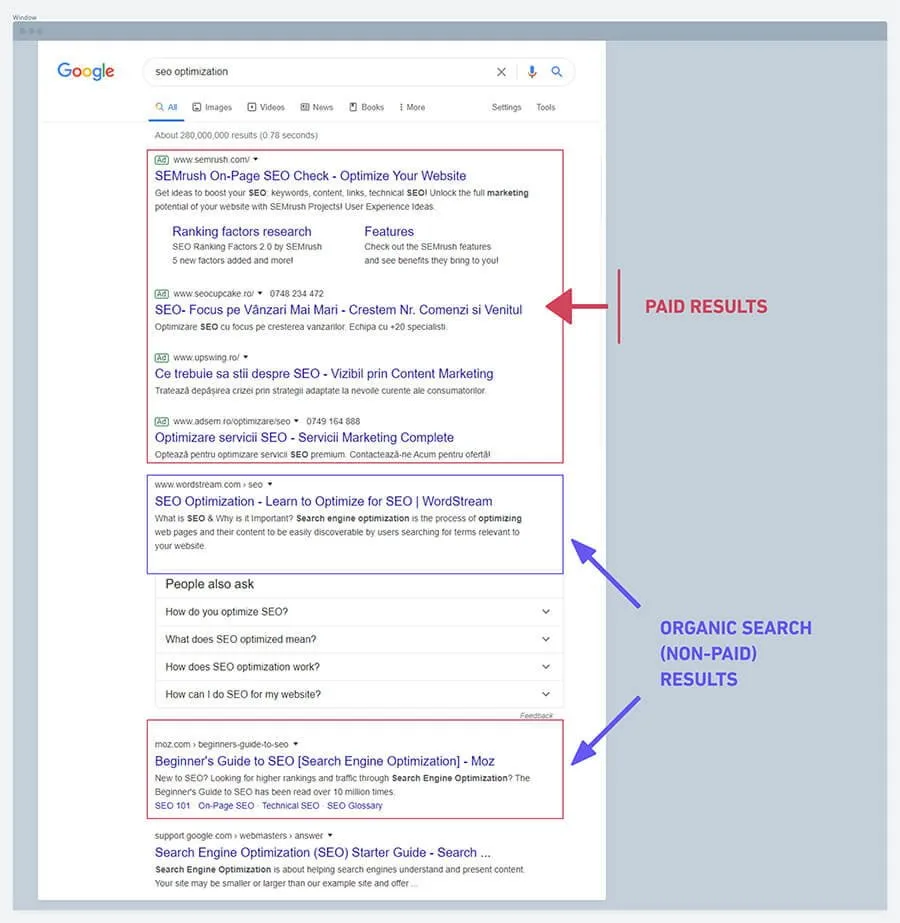
What you need to think about how you can make your site truly deserve that top spot in Google, and how to be a more relevant result than potentially the other thousands of sites that could rank for a particular keyword. It might surprise you to know that Google’s algorithm is proprietary and nobody outside of the company knows the perfect combination of elements to solidify a top spot ranking.
However, at the end of the day, it all adds up to a total grade based on many variables, such as the page structure, and a number of links into your site around the web.
Before you get started with the next part it’s crucial to understand you need to understand that SEO is a long term strategy and you aren’t going to see results overnight.
HOW SEO WORKS?
Every day millions of people search for products or services online and according to the researches of the last years, it was concluded that people rarely access page number 2 after the searched keyword. Most often they will click on the links that are on the first Google search page.
Here you want to find out when your potential customer is looking for your product or services. You can optimize your site by applying different SEO techniques, the purpose being to align with the requirements of Google algorithms. These SEO optimization techniques behave as signals for search engines. Search engines evaluate these signals and then use them to place your site in the top rankings or not.
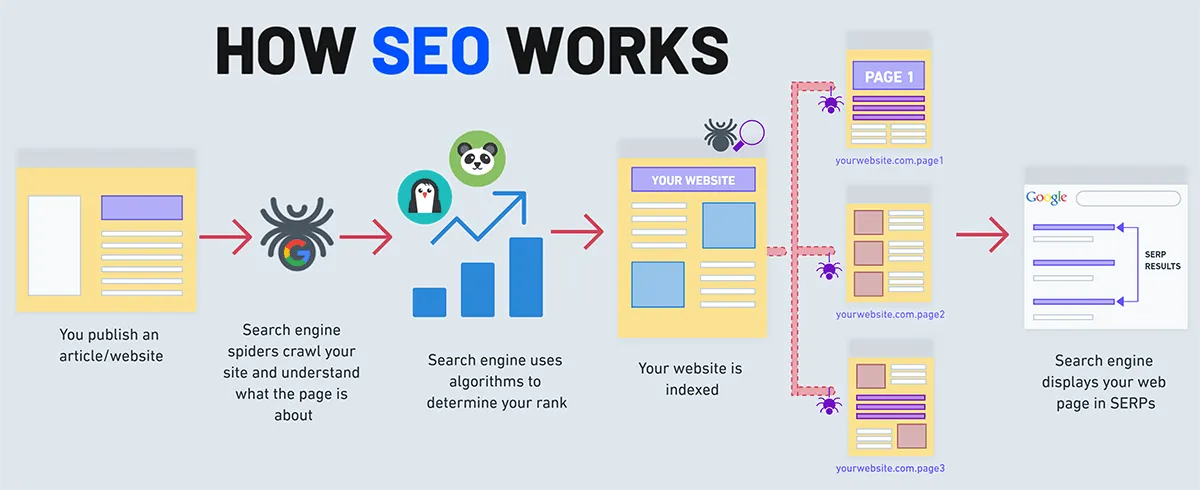
The quality of the content and is an important factor in positioning your site in the top searches. That’s why you need to make sure that search engines understand what is on your page and create content around your page that will be relevant and will match the searcher’s intention.
HOW CAN I LEARN SEO?
If you want to learn SEO by yourself, you must know that this field is constantly changing and every day you will have something new to learn. I will point out a few points to consider when learning SEO.
- Learn the basic principles, basic terms and rules namely keyword research and on-page-SEO
- After learning the above basics you must learn the Technical SEO basic, link building strategies
- After that I recommend to you to get an internship job at a respected marketing agency because in such an agency you will have the opportunity to learn from specialists in the field, you will work with many industries and websites.
- Apply the 80/20 or Pareto rule when you want to learn SEO and you will learn that 80% of the effects come from 20% of the cases. What do I mean by that? I learned a lot by applying this rule about it:
80% of the time I spent putting into practice what I learned in 20% of the time (I learned from courses, from videos, I read tons of articles).
- Make a junk website and practice on that website. That way you will learn very well what you are learning and so you will refine the process.
- Be perseverent. Don’t give up solutions. If something doesn’t work out well, don’t be discouraged.
- Do not try to do more things at the same time because most of the time, nothing will go well.
- SEO is a game and if you enter this game you have to learn how to play it. It’s a game of patience. Be patient and the results will come.
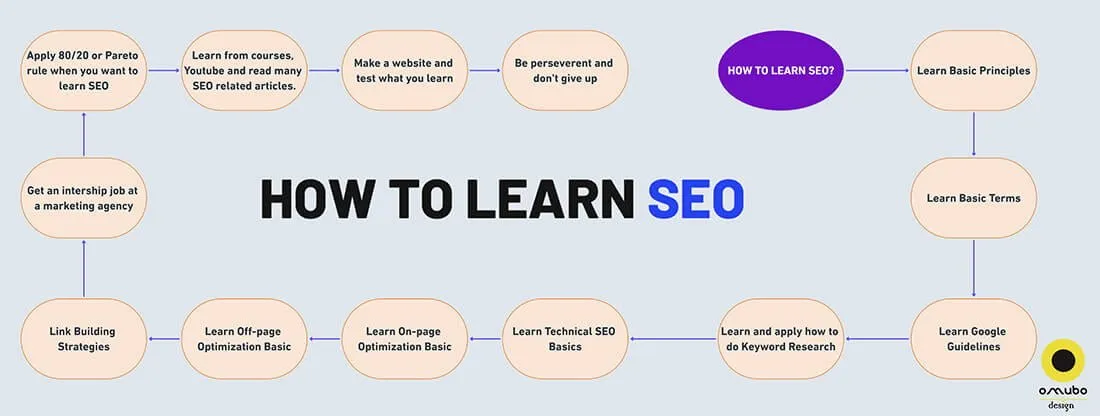
IS SEO DIFFICULT TO IMPLEMENT?
Like I said above, SEO is constantly changing and all search engines use algorithms to discover and index content for each website, then it must serve to the users relevant and high-quality content that satisfies the search requirement of users.
Think that Google uses over 200 ranking factor. Can we identify them all? Yes and no. It depends on a lot of variables.
In the infographic below I try to explain the SEO process.
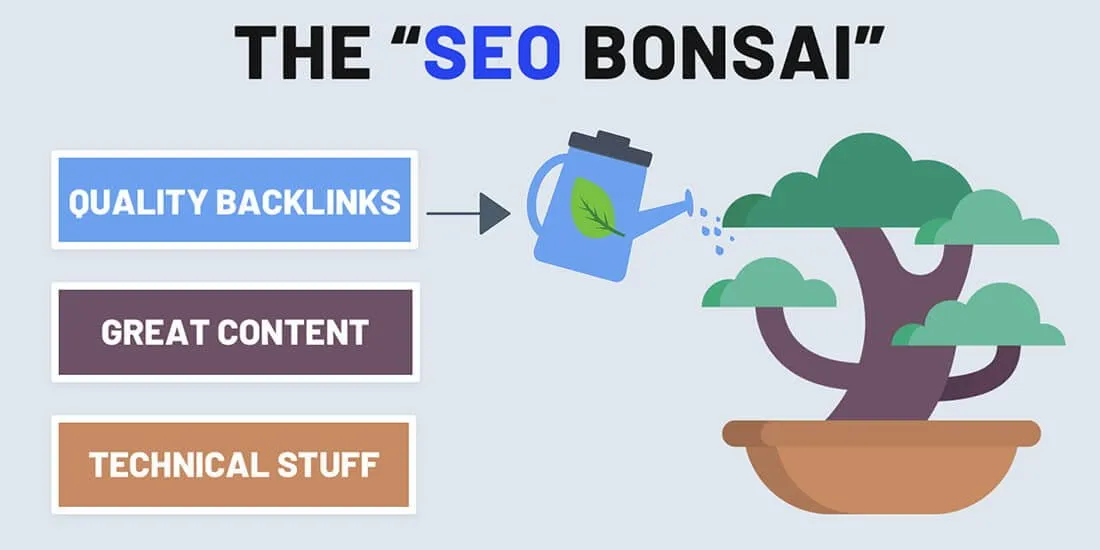
WHITE HAT SEO VS. BLACK HAT SEO
What hat to wear? Or better said which approach is best for you? What hat is right for your business model?
In order to respond to the above questions please let me give you a better understanding of the two techniques.
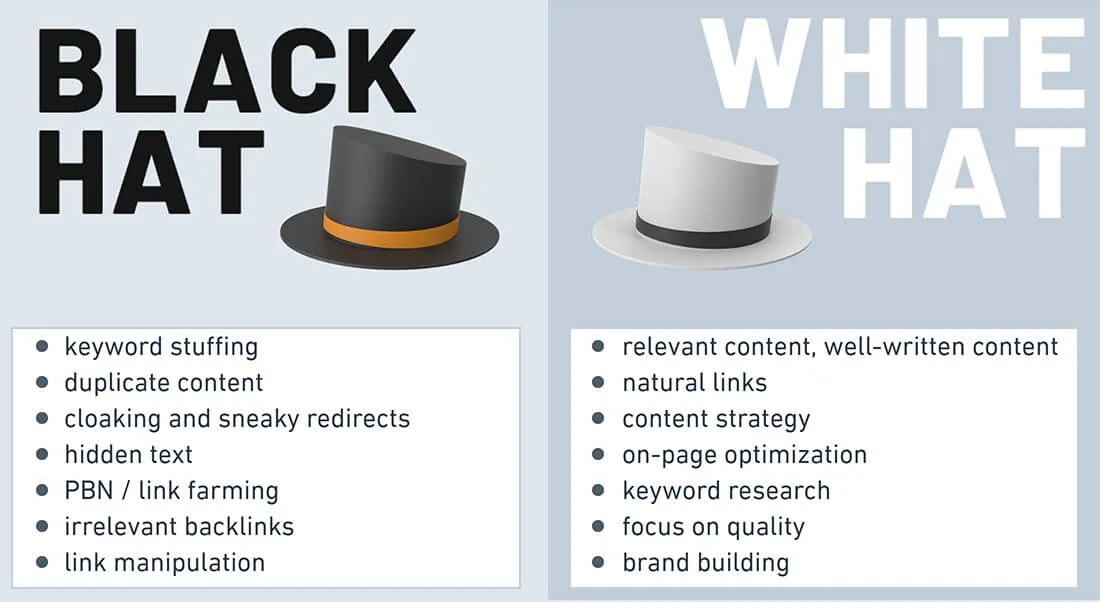
White Hat SEO Basic Understanding
White hat SEO refers to optimizing the site following the exact rules recommended by Google and is implemented following a long-term strategy. The strategies used with this approach take Google guidelines into consideration.
Some techniques used in White hat SEO
- Guest Blogging
- Link Building
- Quality content
- Internal linking
- Site Optimization
We will go through each technique separately in another article.
Advantage:
- Long term strategy
- Best User Experience
- No risk involved
Disadvantages:
- Achieve Search Engine Rankings in the Longest Timeframe
Create relevant and high-quality content for the user
Creating high-quality content should be the most important thing you should focus on when it comes to SEO. People look for quality content and when they find it, they read and share. This way you gain authority for your site, you gain new customer, or you sell your products. You do not have to write content just for SEO because most of the time it will be of poor quality and your ranking will suffer.
User experience also falls into this category because of the content of your article is difficult to read, or the page of your site is hard to load, or the font used is not well chosen, then your potential client or the reader of your blog will immediately leave your site. and he will not return.
Remember: Everything you create should be for the user and not for you or your SEO campaign.
Keyword research is also an important factor, because choosing the right words and understanding your users means better ranking. Help Google Find, understand and then reward your content.
In order to achieve this, it’s a good idea to use Google Search Console and upload your website sitemap and see what issue your site may have.
Remember what I discussed above – Google and any search engine uses those spiders that scan every page of your site.
Also, if your website has a good internal linking structure, then Google will better understand your content, categories, etc. Plus, internal linking will help your users better navigate your site.
Black Hat SEO Basic Understanding
Google hates black hat SEO techniques. Black hat SEO violates the rules of the game in order to achieve in a short time good results in terms of ranking. Sure, these techniques may work great at first and you may even have very good results, but it is not a long-term strategy and, in the end, Google will penalize your site.
Remember: Google is very smart and is in a continuous learning process.
You will mention here some black hat SEO techniques but if you want to know more about the differences between Black Hat SEO vs White Hat SEO you can do it in this article.
- Steal content
No, no, no. This is bad. It is also known as plagiarism.
TIP: Be unique.
- Link farms – Imagine a lot of sites that link to each other. There was a time when this tactic worked wonderfully, but now it’s easy to get caught with “the cat in the bag”.
- Keyword stuffing – Creating web pages with the intention of entering in these pages a lot of keywords, for which it is desired to rank-ing, to send signals to the search engines.
- Purchasing links – just do not do that.
- Hidden text
- Cloaking
- Article spinning
Advantage:
- Achieve Search Engine Rankings Fast
Disadvantages:
- Short term strategy
- High-risk penalty
- Poor user experience
Search Engines

HOW GOOGLE RANK A WEBSITE?
So, I’m going to explain a little bit about how Google actually rank your website.
Think about going to a Google page to search for something that interests you a lot. You do this by writing something in the search box or speak (Alexa, Brizy, Cortana, Siri) or by asking a question. Then, as if by magic, in front of your eyes are displayed a series of links to the lead to certain web pages that is possible to answer your question.
But what lies behind this magic?
There are three main terms you need to understand
- Crawling or Discovering de content
- Indexing
- Algorithm
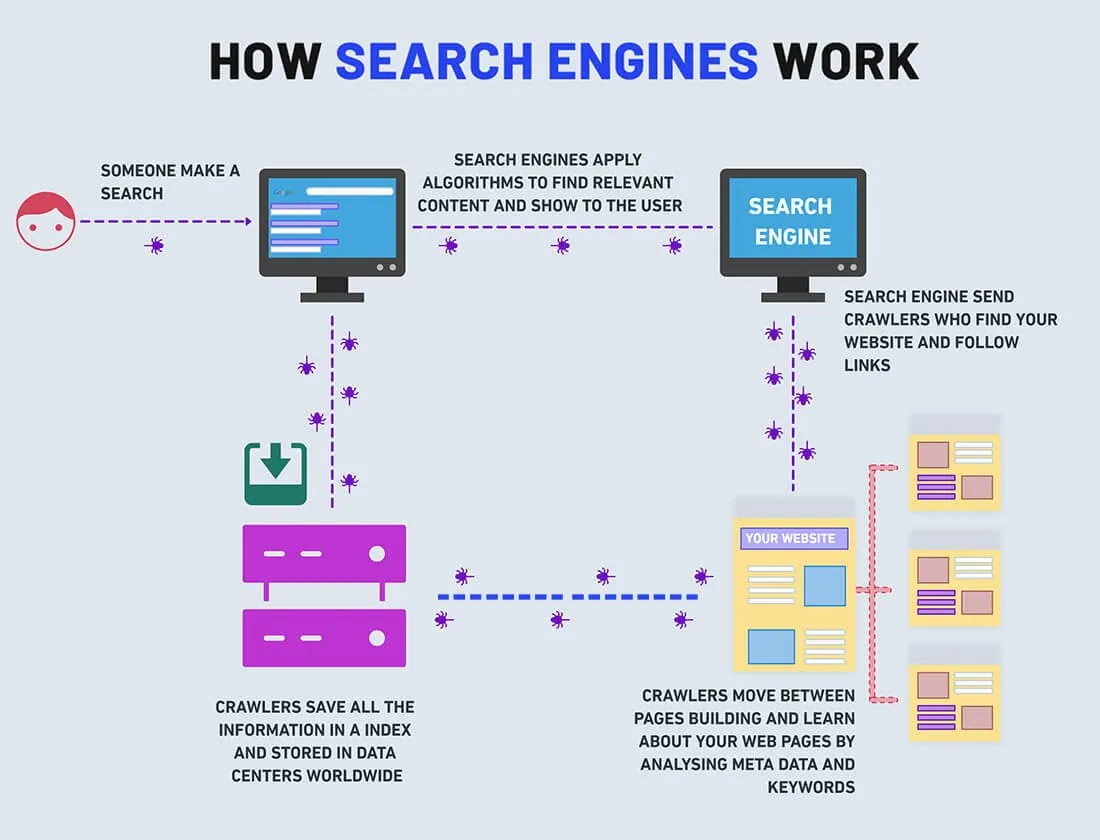
Crawling
Googles use crawlers, also known as spiders, which scan all information from all over the web and then the process repeats at a certain time to see if those pages have changed. If they have changed, then scan those pages again and update the information.
Indexing
Once that little spider crawled a web page, the copy he made is returning the search engine where they will be stored in a very large database. This database means a lot of servers where all the information is stored and originated to provide the best response for users. So indexing is the process of organizing and storing information, to be served to users in a fast and relevant way.
Algorithm
After discovering and indexing content, the next part is search engine algorithm. Its purpose is to present to the user relevant and high-quality content that will meet the needs of your searches.
Quality Rater Guidelines
Google Quality Raters is used to help improve the search experience for the users and according to Google “are spread out across the world and are highly trained”.
In order to find out what these raters are looking for when analyzing the results, we have to go through the following points:
- The intent of the Query
- Credibility Signals (known as E-A-T)
- Quality of the Content, Page, and Site
- Your Money or Your Life Pages or YMYL Pages
Quality raters follow a long document published in January 2020 that explains in the 168 pages what sets a good result and what the raters should look for to identify bad results.
Below is a brief overview of what Google raters are looking for to identify quality content.
Intent of the Query
When the raters are looking at the search results, they stay focused on the intent of the user in order to provide the best solutions to help the user. When Google recommends a certain type of content to users finding a solution to their problems, that content must bring value to users.
Credibility Signals (known as E-A-T).
E-A-T is an acronym used by Google to define global credibility of a website and stands for Expertise, Authoritativeness and Trustworthiness.
This essential evaluation plays an important role in Google updates and affects YMYL (Your Money Your Life) sites with E-A-T issues.
E-A-T Components
- Expertise – This component is very important for medical, legal or financial websites because by “expertise” you need to show the skill of the creator and to mention the creator in your content.
- Authoritativeness – refers to the site itself and includes reviews, credentials, testimonials, etc.
- Trustworthiness – you need to show your users that they can trust your site and involve site quality and factors such as site security.
What do we know about E-A-T?
1. E-A-T is not an algorithm
E-A-T is based on links and mentions from authoritative sites and is not an algorithm in itself. Algorithms Google searches for signals and mentions both on and off-site to reach a ranking score.
2. E-A-T is not a ranking factor
3. Building E-A-T takes time and effort
It is important to increase your brand by improving the confidence that your users give you when they trust your site, your brand or trust you as an author.
4. Adding Author Biographies to your blog posts is not a ranking factor
It is a good practice adding author biographies to your blog post in order to improve E-A-T, but you need to pay attention that the persons who write the article is an expert in the field and knows exactly what they talking about in that article.
5. Not all site owners need to focus on E-A-T
YMYL Pages
YMYL is the acronym for Your Money Your Life and is a concept introduced by Google for quality raters. According to Google Guidelines, this term describes any page content that can influence someone’s health, happiness, safety or financial stability.
The industries that are included in YMYL are:
- eCommerce
- financial sites
- healthcare
- legal
- news

Important: Make sure your website content will help the people by offering good quality content and not hurt them.
Quality content, page and site
It’s simple.
Google wants to offer its users the best user experience (UX) and the quality raters carefully monitor the ratio between quantity and quality of content, navigation and responsive design.
The raters will also sound the alarm when the content is poor in quality or lacks credibility or misleads users.
Google will exclude this type of content that will do more harm than good to the user.
Pay attention to these 6 considerations related to Google Quality Rater Guidelines.
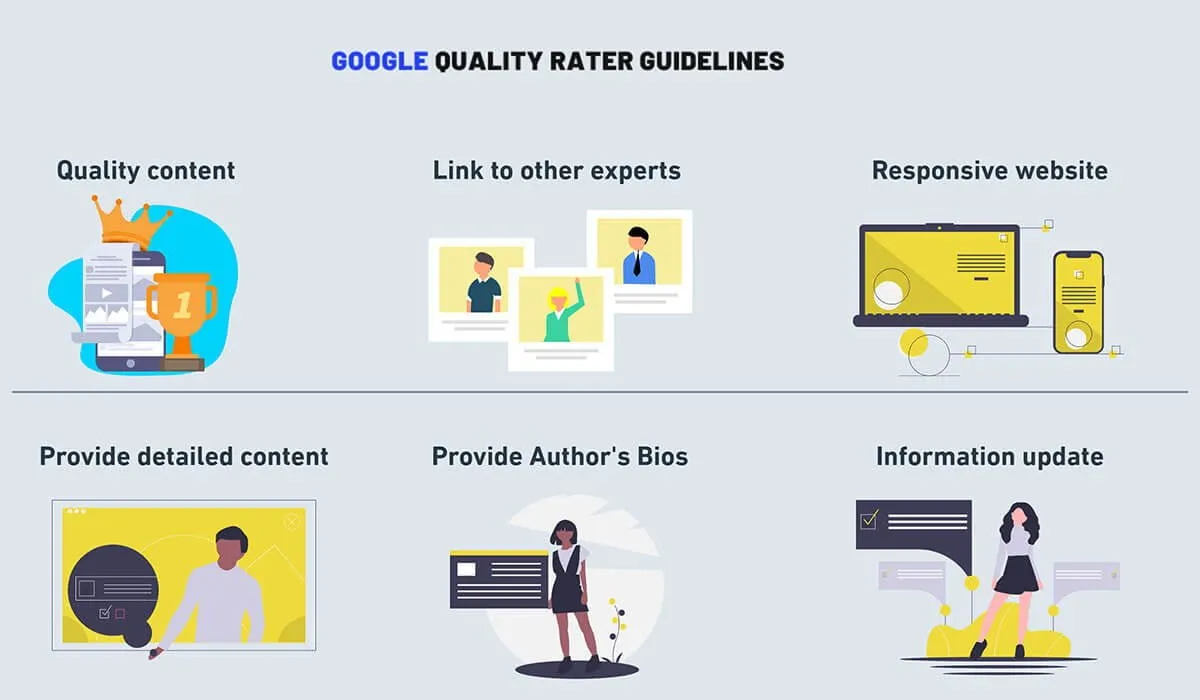
Ranking Factors
As I mentioned above, there are over 200 ranking factors used by Google to rank your website. But what are the most important factors gonna focus and make a difference in rankings?
We have divided the most important ranking factors into two major categories that can lead to success for both searchers and search engines.
- On-page ranking factors
- Off-page ranking factors

On-page Ranking Factors
These on-page ranking factors are split into:
Content
Quality Content – All pages must be well written and have niche-specific quality content.
Media – you have valuable news, videos, images, infographics, etc.?
Keyword research – you need to research the keywords people may use to find your quality content
Content answers – your content answers users’ search queries?
HTML
Title tag – your title tag needs to contain relevant topics keywords
Header tags – make sure your headlines and subheads use header tags with relevant keywords
Meta description tags – describe what the page is about using meta description tags
Hidden words – make sure that your design or text colors don’t hide words you want pages to be found for.
Keyword stuffing – make sure you don’t use unnecessarily repeating words or phrases, using keywords that are not relevant to the topic of the page or adding words that are out of context.
Architecture
Mobile friendly – your website needs to work well for mobile devices
Speed optimization – your website pages load quickly?
HTTPS – your site must ensure a secure connection for visitors
Friendly URLs – your site URLs must contain keywords related with the page topic
Crawl – make sure that search engines can easily “crawl” the pages of your site
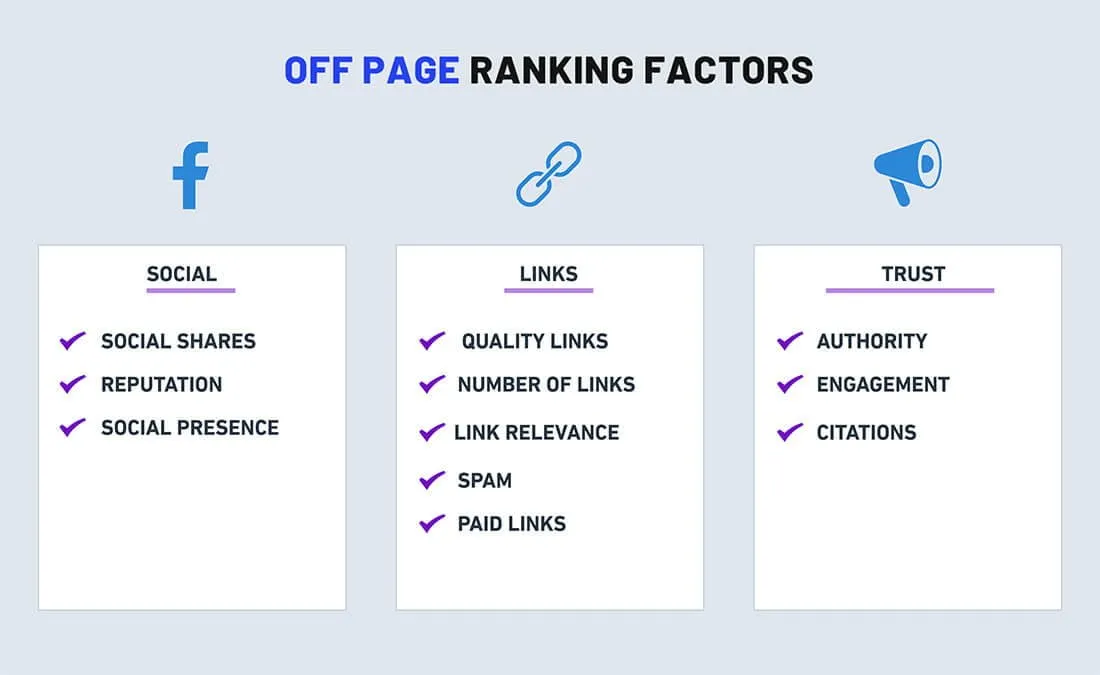
Off-page Ranking Factors
These off-page ranking factors are split into:
Social
Social Shares – it has to do with how much your content is shared on social media
Reputation – how many people on social networks share your content
Links
Quality links – ensure that links are from trusted and respected websites
Number of links – how many domains in linking to your website
Link relevance – it is recommended that the sites that are linking to you are in the same niche
Spam – do not create links spamming forums, blogs or other places on the web
Paid links – don not purchase links for better rankings
Trust
Authority – this is a lot like page PR. Do links, shares or other trust factors give authority to your pages?
Engagement – ensure your visitors spend quality time reading your content
Citations – validate your business as trustworthy by listing your business NAP (business name, address, phone number) on high authority websites.
Search Engine Market Share
Which search engines people use the most?
Search Engine Market Share Romania
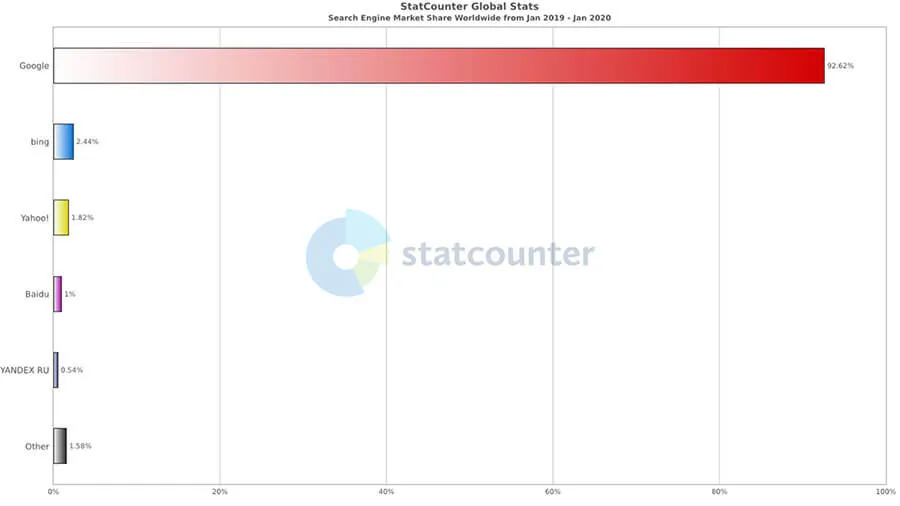
User journey in using search engines
In order to provide the best user experience for the users looking for information or products or even ordering something from the internet, an SEO campaign must be friendly with both search engines and users.
In the image below I described the customer journey.
- User intent principles
- I need a piece of information, solution, answer
- Search with the specific keyword for that information
- Going to the first results
- Click on one or more websites
- Open website and see if the information is what I need
- Going to see more results on the 1st SERP or I change my search query.
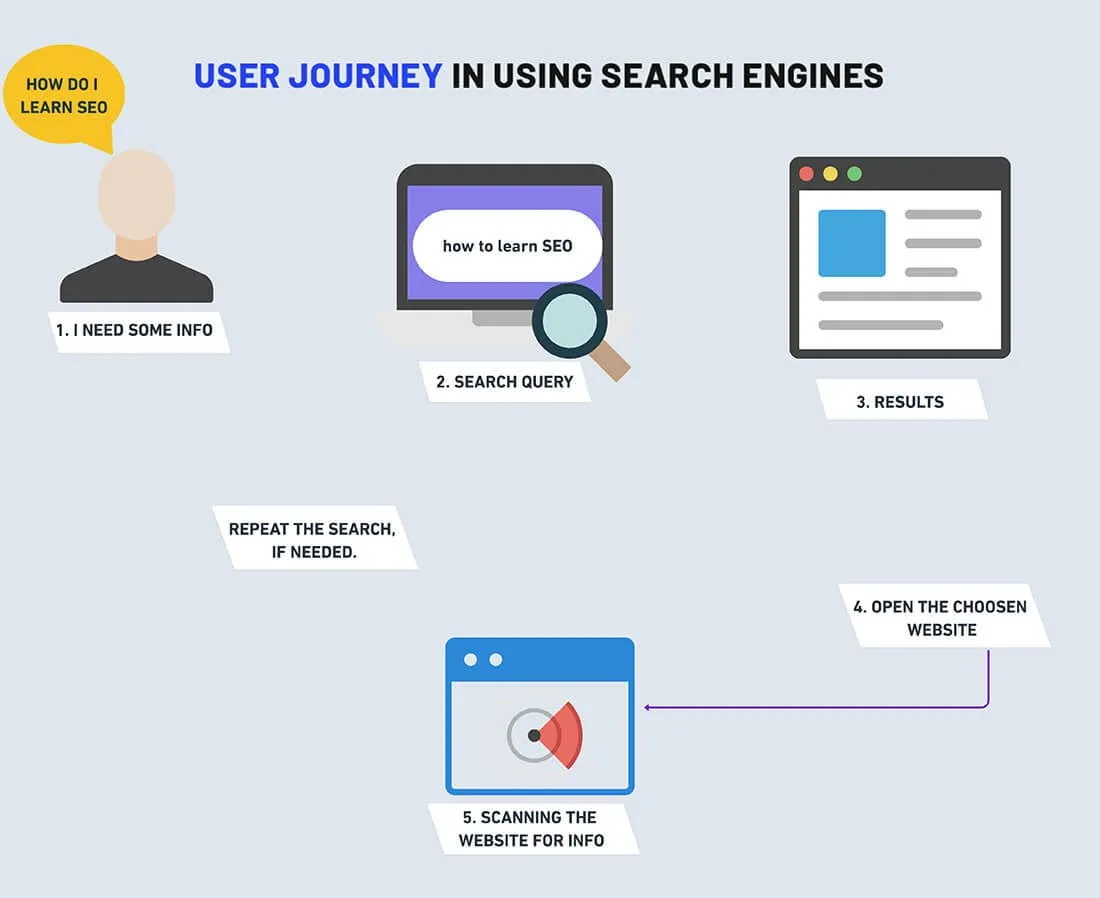
How we classify search queries
If you will understand why people are searching and different types of terms, they’re searching you’re going to be able to create great content around that’s going to drive them in the right direction.
Navigational Search Queries
In this type of search queries the user already knows where to go.
Exp: Let’s say you need to book a plane ticket to fly somewhere and you know exactly which airline you want to fly. This traffic value is very high.
Informational Search Queries
This search represents 90% of din search queries online. Here the users are looking for information. This traffic value is medium.
Transactional Search Queries
These are the people who are ready to take a step forward and move on with you or your business. A user who wants to make a transaction with your business, to conclude a contract with you. Here traffic is high.
Content & SEO

What content should I create for my website?
This it’s a huge huge question and which I get asked all the time, at the workshops, at the pub’s, my clients, all these people are asking me this question “What content should I create for my website?”.
Types of content:
Blogs
Blog content is a popular method used by both small and medium and large companies to add value to their business. Blog posts is a good way to create a long-lasting relationship with your readers, to make your business known and to bring traffic to any site.
Blogging benefits:
- Very good content drive traffic bt 2000%
- Companies who have a blog and provide value to the users receive 97% more links to their website
- B2B businesses that have a blog receive 68% more leads
- When your blog has between 21-54 written articles, good quality, the traffic generated increases by 30%
- You’re a setting apart as an expert in your field and attract more benefits for your business
- You can meet interesting people in your industry and make valuable connections
Reviews
Reviews articles refer to those articles that make a summary related to a topic. They are also called survey articles or overview articles because they summarize some previous studies. They can be shaped:
- Products reviews
- Research reviews
- Services reviews
- Advantages and disadvantages
- Discoveries
Case studies
Case studies are the stories of your clients and they illustrate how your business helped your client get more sales, more leads and become more successful. Case studies are a good strategy for highlighting certain applications, and this type of content helps to better understand how your company brings more value to other people or businesses.
Case studies can be used when writing a blog article, in your marketing strategy, in eBooks, social post, and another type of content. If you have a sales team, this can be used by case studies to demonstrate the effectiveness of the products sold by the company, as they have helped other customers, so they can sell more products by making more money for your business.
Podcasts
What is a podcast?
The podcast is a piece of audio or a story or an interview or a documentary series that you can download and listen to whenever you want. In 2014 the podcast phenomenon exploded and started to become very popular. Today more than 100 million people are listening to 18 million episodes every month from the 700,000 podcasts out there.
Why you should start a podcast?
Podcast Benefits:
- it’s personal and real because listening to somebody’s voice in an audio recording can convey more emotions
- it’s convenient for people because your audience can listen to your podcast whenever they are free
- It’s easy to do – you can use your smartphone to record a podcast then upload it to the internet
- It’s a simpler way than a blog post because you’re talking rather than writing and you can say more in a shorter space of time
- You can reach new audience
Infographics
Infographics have a visual representation of taking some data and building a story around this data, which is easy to understand. They are a good way to create brand awareness and position your company as a leader in your industry.
So, including infographics in your content strategy is a great way to provide educational content and share your data and social accounts or on their site. When you create infographics for supporting your content, think of what your audience would like to learn. Make your infographics an impactful story.
Guides
Guides usually have long epic articles or videos that describe in detail a process, the use of a product or service offered.
How-tos
This type of content is the most popular and have long tail search potential which is good for marketing purposes. This can be both written articles and videos. If you’re wondering why “how-to” content is so important in a search engine, it’s because people use Google to find solutions to their problems. If your “how to….” Articles are very good for your audience then this piece of article will be shared, become valuable to others and you and your business will have long-term profits.
Tips, tricks and hacks
You can write blog posts about tips, tricks and hacks in order to share your experience and help others find solutions to their various problems. These can come from personal experience or for example when you accidentally discover a hack you want to share it with other people in order to help.
Videos
Google love video content. Videos are everywhere and become the most powerful digital marketing tool today. People like videos because they are effortless to watch, can be educational, entertaining and informative, just like well-written content and are delivered in a more convenient way. Take for example videos on the Youtube platform that receives millions and millions of views daily. Not to mention the new TikTok platform where you can watch short and impact videos. It is the most share-watching type of content. Take Facebook as an example. When you watch a video on your Facebook feed this video plays automatically forcing you to engage with it. Videos can double the time spent by a user on your site and can generate 3 times more inbound links and have a 41% higher click-through rate for search.
Interviews
You can create content for interview sessions with experts in your field in order to bring value and inform your site visitors about the products or services sold. Thus, you help your clients or potential clients to better understand the products or services you offer and that you are a leader in your field.
Ebooks
eBook’s stands for electronic book and represents a digital version of your manuscript and can consist of text, images or both.eBooks have a long-form piece of content and in recent years has become a “must-have” for all businesses. Why? Because eBooks can provide value to customers and attract more leads. You need a very talented writer to tell your story because a well-written story can transform your eBook into a lead magnet.
eBook Benefits:
- Save money in baggage fees at the airport.
- You can have it on all your devices
- You can highlight text
- You can remove highlights
- You can take notes and find your notes quickly
- All your notes sync between devices
- You can share your highlights and notes and get feedback
Duplicate Content
What is duplicate content?
It’s exactly as it sounds, duplicate content means that a copy and the content on your web pages are duplicated either on your own website or on another website across the web. If you have a piece of article, an exact copy of that text article is put on another page of your website, that is duplicate content.
What if you need to keep both pages on your site even if it’s duplicate content? In this scenario, you need to tell Google which version of the page you want to index. To do this you need to set a canonical tag like rel= ”canonical” or to use 301 redirects.
You can find out more on Google Search Console help pages.
If you copy someone content copy and put it into your site because this is plagiarism and Google will penalize your site.
If you want to detect plagiarism, I advise you to use Copyscape. This tool will help you see if the content of your site is unique.
What’s the ideal content length?
The content length is not straightforward as it seems and depends on the type of content you are creating and the king to answer the person searching for. But what is the optimal length for a blog post?
When you search for this information on Google you will read many opinions directly related to this question. Many of these “good opinions” just misinform because they have no case studies conducted in-house.
To figure out what length an article should have, you should first look at your keywords and search results to see what works and what doesn’t, and at which point you are free to innovate.
For example, the first 3-4 search results are in these sorts of averages and you think you could answer this with much shorter content, or you will see that many searchers would appreciate your content much more. You should match your goals and your content goals with searcher goals. This will determine the length you should write.
Keyword research

The very first step in search engine optimization it is also a crucial step to create great content for your website. Through this process you will discover how difficult it will be to beat your top competitors from the first Google search page for the keyword you want to rank. It is very important that this process take place because if it is done as it is in the book, you might find some keywords that no one is hunting and take advantage of it.
So how do you do keyword research?
What is a keyword?
A keyword is a word that we are targeting for SEO.
It’s basically what a keyword is.
Keywords are made up of branded terms and non branded terms. Keywords can be a single word or made up of several words in a keyword string. Longer keyword terms typically have lower competition and are called long-tail keywords. As mentioned, some keywords have a high competition where it would be nearly impossible to rank on page one, and some keywords have very low competition, and page one should be pretty easy to rank for. Typically keywords with the higher competition will be the words that have more search volume, and the lower competition keywords will have lower search volume. Now the sweet spot is ranking for keywords that have a moderate/medium competition and moderate search volume.
Where I find keywords?
Method 1: Brainstorming
Even before you start creating your site, it is very important to brainstorm and think about all the keywords specific to your niche for which you would like to rank. Write these keywords on a piece of paper. After you’re done make a spreadsheet and put your keywords there.
Let’s say you are a handmade tennis manufacturer.
Ask yourself what topics people on Google are looking for that are relevant to your field of activity. This is how you try to think of what your client might be looking for on Google when looking for something to wear.
If I think a little about topics, I can squeeze in a few words:
- Handmade sneakers
- Handmade shoes in Romania
- Tennessee producers
- Romanian handmade products
- Keep them unique
TIP: Put the word list in the spreadsheet.
Method 2: Google and Youtube suggestions
Using the list above go to Google and write the first topic and see which is the first suggested group of words. Google will suggest more keywords that you need to copy and add to your spreadsheet.
Repeat this process using YouTube as well.
Case studies can be used when writing a blog article, in your marketing strategy, in eBooks, social post, and another type of content. If you have a sales team, this can be used by case studies to demonstrate the effectiveness of the products sold by the company, as they have helped other customers, so they can sell more products by making more money for your business.
Method 3: Find keywords using Google Keyword Planner
Steps:
- Create a Google Adwords account and open it up.
- Select the find new keywords option
- Enter some keywords ideas
- Press GET Started button
- Next, click on the location – and select which country you are targeting
- Then click “Show broadly related ideas” filter
- Here you can choose from:
- Broadly related ideas – returns lots of different keywords ideas
- Closely related ideas – brings more relevant keywords ideas
- Click to select all keywords and then click to select “exact match” from the dropdown
- Click add a keyword to a plan before clicking the link to view your forecast
- Now you will see all of you keywords ideas and their exact search volumes
- From the table click “Clicks” column to bring the keywords with the most searches to the top
- Download the list by clicking the button from top-right of the screen.
Things to consider
Google Keyword Planner doesn’t tell you how difficult is to rank for a keyword. That’s why I create the FREE spreadsheet that will help you find all the easiest to rank for keywords with the highest search volumes. Just download this spreadsheet in order to be able to build an intelligent keyword strategy for your business.
Method 4: Keyword tools
If you search on google for free keyword tools you’ll find a lot of them. Aceastea o sa-ti ofere sute de idei de cuvinte cheie ce le poti folosi imediat in procesul de optimizare SEO.
Deeasemenea exista paid keywords tools care iti vor oferii si alte bonusuri ca SEO metrics, insights si chiar poti vedea pentru ce cuvinte cheie rank your competitors. You can use this tools for every element of SEO.
Some of paid keywords tools are:
- Ahrefs
- Semrush
- Moz
- KWfinder
Another great tool is AnswerThePublic, we use this tool a lot in our agency because automatically generates hundreds of Google suggestions.
With keywords research these tools you can:
- Get traffic forecast for target keywords
- Generate a list of LSI keywords
- Select primary and secondary keywords
- Choose keywords with high search volume
- Identify the keywords that your competitor are ranking for
- Etc.
Method 5: On other platforms
If you do not have an account on these platforms then you should do so because here you will find a lot of keyword ideas that will help you in your research strategy.
- Youtube
- Quora
Keyword metrics
Every SEO has a favourite metric for keyword research. Some look only at volume while others look at Keyword Difficulty. It’s critical to know exactly what each of these metrics means to be able to prioritize which keywords you really should go after.
This is often the critical difference between a successful SEO campaign and a waste of your hard-earned money. In this video, we will be explaining in detail what each of the keyword metrics really means and why it’s important to know the separate on-page and off-page Keyword Difficulty metrics to help you choose the right keywords to target for your website.
Metric search volume
This is the new number of times that the keyword phrase has been searched on Google every single month for the last 12 months. When we know how many searches a keyword phrase has per month, then we can gauge how much traffic that keyword can send to our website. Obviously, the higher the search volume, the better as long as you can rank at the top for the keyword.
If you are an online business that serves customers from anywhere in the world, then you want to look at the global search volume. However, if your business only cares about customers in a specific country, say the US then you should be looking at only the US search volume. Some keywords might be searched a lot outside the US and almost none inside these would be disastrous keywords to target. Some keywords are seasonal.
So for example, people search for Christmas gift ideas starting from the latter part of the year and the monthly volume for this keyword increases till the end end of the year and then drops drastically.
In these cases, the trend of search volume will show the seasonality and the search volume will show a much lower number than the actual volume in the spiking months.
Keyword Difficulty score
This number tells you how to optimize the top 10 results are for the specified keyword. Here’s how this has helped calculated, we scrape Google for the keyword and get the top 10 results shown. We then scrape each of these sites and figure out whether the site has the keyword and its title, description, heading tags and in the HTML content, and based on this, we give each site a score. We then total up the score for all 10 results and then normalize it to a number between zero and a hundred. Using this number, you can figure out whether you can rank for this keyword by merely optimizing your content for the search engines. If the number is low, you might be able to rank simply by putting the keyword and important places like your title, description, heading tags and in the content. I’ll come back to what scores I’d like to see.
After you decide and have a list of keywords, it’s time to see how hards will be to rank. This process is very important because here you will map your keyword building.
The difficulty score is indicated using a scale from 0 to 100 like in the infographic below.
Long-tail keywords vs. Short-tail keywords
Differences
Short tail keywords can bring you traffic to your website but no traffic, and long-tail keywords can bring you less traffic but more profit.
Short tail keywords have high competition with a low ROI
If you implement long-tail keywords in a smart way, you have less competition, a few visits but the ROI will be very high. Plus you will attract the right audience to your website.
Long-tail keywords
What is a long-tail keyword?
A long-tail keyword is a variation or a longer, more specific search phrases with 3+ words. They are dead, telling us that the user knows exactly what they are looking for, thus increasing the likelihood that he will make a decision.
Example: „Best handmade sneakers brands” – This is a long-tail keyword
Why should you target long-tail keywords?
- Long-tail keywords have lower search volume and are not as competitive as short-tail keywords.
- Will be much easier to get rankings
- A long-tail strategy can work wonders in an SEO campaign for your business.
Search intent
The whole process looks like this when a person searches something:
Information – Investigation – Transactional
Example: the keyword „ handmade sneakers” have huge competition and will be hard to rank for – this is informational
The keyword „best sneakers manufacturer in Peru reviews” – this is an investigation
The keyword „best handmade sneakers in Peru prices ” – here the user wants to buy a pair of sneakers. – and this is transactional
LSI (Latent Semantic Indexing) keywords.
This a fantastic tactic that you should be using all your SEO copy. If you have to rank higher your articles in search engines you should start applying latent semantic indexing principles to your copy.
What are LSI (Latent semantic indexing) keywords?
LSI is a mathematical algorithm that helps the contextual connection between words, and Google uses to understand the context of a piece of content and how words are related and fit together.
LSI is additional relevant keywords, that aren’t necessarily synonyms, but is incredibly contextually relevant to your primary keyword.
On-page seo

On-Page SEO
Now we want to look at SEO on an individual page basis. I’m going to show you why that is important to do and give you a brief overview of the things that we’re going to cover in this section. So, the reason it’s important to look at SEO on an individual page basis is because Google in the search results, lists the most relevant web pages, not the most relevant websites.
SEO Checklist
Title Tag
Now that you have a page in mind and the keyword what is the URL for that page and is the keyword in the URL The target keyword in the title of the page, is the keyword in the h1 tag of the page. This Title tag will tell to search engines what your page is about. This need to be 70 or fewer characters and including both keyword your content and your business name.
Meta Description
A good optimized meta description should be between 50-300 characters, because google wants to give users the best answers to their questions. Your meta description shoud user you main keyword and Google will bolded this keyword, also to offer the best experience to their users. Also keep in mind that you meta should be unique for each page and hand write every single meta for all your pages.
Headings and Sub-headings
These tags are meant to improve the process of on-page optimization but also user experience. Also, this will help you organize your page because it works as a break-up text and will guide readers through the page. It is recommended to use a single H1 tag on the page and this can be the same as your title tag. For the rest of the tags (H2, H3, H4, H5, H6) it is advisable to use other targeted keywords, synonyms or related phrases.
Use SEO-friendly URLs
This is an important ranking factor.
- Include your target keyword in your URL structure
If you have a product to sell, let’s say handmade sneakers your URL will look like this:
www.example.com/handmade-sneakers
- Avoid dynamic parameters – A dynamic parameter is something you see in a URL when there’s an instruction on your website to dynamically serve content via the URL and the URL look like this:
www.example.com/?string=123456
- Avoid using STOP words – is a word within a URL that breaks up your keyword. If your keyword is „handmade sneakers in Peru”, then the URL should look like this:
www.example.com/handmade-sneakers-peru – without „in”
- Limit the number of folders and the hierarchy of your website – every time you have a forward slash in your URL, you’re going down a level in your website hierarchy like in the example below.
www.example.com/handmade-sneakers/black-sneakers/peru
- Case sensitivity – all your URL’s should be lowercase
- Separate the keywords or the words in your URL with a
- Avoid keywords stuffing – mention only one time your keyword in your URL and not multiple times because this is spammy and will hurt your rankings.
Multimedia
If you want to engage more with your visitors, then you must use multimedia such as eye-catching images, infographics, videos or charts.
Quick tips:
- Use high-quality and eye-catching images to make your website look professional. Add alt text to your images and name your images like „men- wearing-a-pair-of-sneakers”, reduce the size of the files.
- Using videos is a great way to engage with your website visitors. You can embed your videos and add a transcript to them.
- For infographics, you can use Canva, Piktochart or Easel.ly
Outbound and internal links
Outbound links link to a website outside of your own and send visitors away from your website to another piece of content related with what is found in your website page. This work directly with anchor texts. Anchor texts are clickable, visible and hyperlinked text found within a web page.
Internal links are the hyperlinks that point to other relevant pages on your website and help Google to better understand your site structure. It can also be considered a method of promoting other content from the website.
Internal linking is one of the most important ranking factors, the context you make your internal linking is as important as the anchor text around the links.
Technical On-page SEO Checklist
Search Console
Anybody is doing SEO need to connect a website to Google Search Console in order to make some tech analysis and getting into the technical weeds of an SEO audit.
This tool offered by Google helps you identify if your website performs well in search result if the website has penalties, how your keywords perform, CTRs and many useful data.
You need to select a property type and here you have 2 possibilities
- Domain method
- URL prefix
Domain Method – requires you to go to your domain name server settings or records and add some text in there
URL prefix – this is the old method and can be done in 4 ways:
- Put a small HTML file web page on the root folder of your website
- Can get a code to put in the HTML head of your web pages
- Google Tag Manager
- Google Analytics
Website Speed Optimization
Website speed is a ranking factor and refers to the loading time at which web pages or media is downloaded hosting servers and displayed into a browser. You need to improve the speed of your website if you do not want your visitors to leave your site. If the website doesn’t load in less then 3 seconds, visitors will leave your site.
Quick tips:
- You can test your website speed by using various tools such as:
- Page Speed Insights
- GTmetrix
- Webpagetest
2. Optimize your images, CSS and JS minification, HTML compression, GZIP compression and decrease server response time
3. Your hosting provider is a very important aspect of loading speed. Choose wisely.
4. Localised server (also a ranking factor)
5. Use a cache plugin if you use Wordpress.
Mobile optimization
What is Mobile Optimization?
If you’ve ever talked to someone who works in web design, then you know that designing a site that runs smoothly on all devices is a pretty hard job.
Mobile optimization is the process of providing your site visitors with an engaging and user-friendly mobile experience. You need to optimize for that specific device.
Sitemap
Sitemaps are really important when it comes to SEO because helps Google understand and find your content.
What is an HTML sitemap?
An HTML sitemap is a page that contains a list of all the pages on your site, including links to those pages. So when Google crawls tour website, it makes a lot easier to find your content.
What is an XML Sitemap?
An XML Sitemap is a file built-in XML that redirects Google to find all relevant pages of your website and can be considered as an instruction manual for Google.
Robots.txt
What are Robots.txt files?
Robots.txt it’s a tiny little file, but it can create a lot of problems. The robots. txt file has a couple of functions that don’t seem very important, but it can become a very important file if you forget about it.
You see the robots. txt file is just sort of a welcome to a search engine, or to a software program called a bot or spider. This is where search engines look to find any instructions that the webmaster has for them.
The robots.txt file welcomes the search engine bot to the website, and lets them know here are the areas of the site that you are allowed to go copy content and, more importantly, it lets us know here are areas of the site that I don’t want you to spider and that I don’t want you to download, very similar to people that arrive at your door.
If you have a welcome mat or even if you don’t have a welcome mat, they’re still going to come just like a search engine spider. And when people come into your house you welcome them in. And you also tell them not to open the closet door where you put everything in there and shut the door shut, so no one would see the mess.
That’s what the robots dot txt file is, it lets the search engines know that I would rather you not index this information. Now, it could be for several reasons, and we’ll get into those. But the basic protocol of a robots.txt file is to identify the user agent, that’s the bot.
Technical SEO hacks
HTTPS vs. HTTP
HTTPS stands for hypertext transfer protocol secure.
Now when you enter a web address you notice on your address by your dash HTTP or HTTPS.
HTTP is simply just hypertext transfer protocol, why HTTPS, the S means secure. And then we talked about user experience with HTTP as you can guarantee your users that whatever that the data they’re exchanging on your website, it could be the email address your credit card details, probably they’re trying to perform a transaction, you are telling them that it is secure.
What HTTPS, it tells you that you have an SSL certificate, a secure socket location, that means whatever data they’re exchanging on your side is encrypted and it is secure. This is very important to SEO because search engine also considers the security of your site when it’s ranking it. A lot of people might tell you this is not relevant for your SEO ranking.
But the search engine always considers your site security, you want to make sure that your website is secure. And you want search engines to index around your site as one of those secured websites.
Check the resource section for more information on how to get an SSL certificate such that when people enter your web address, instead of the just HTTP, which is not secure. You are the HTTPS. That HTTP is a hypertext transfer protocol that is secure for users on your website.
Canonical Tags
What is a canonical tag?
When there are two duplicate pages, it is necessary to define the main version of the page using a fragment of HTML code called canonical tag which has the form:
rel=”canonical”
<link rel = ”canonical href =” https://www.someurl.com/somepage ”>
By doing so, you tell the spiders which version of a page to index.
Why canonical tags are important for SEO?
The correct use of canonical tags improves the SEO results for your site. Nobody likes to see two similar or identical information on a site, right? That’s why Google doesn’t like duplicate content for several reasons, such as:
- You will not know which version of the page to index
- You won’t know whether to split “link equity” between multiple versions or use it for just one page
- You will not know which version of a page to rank
Link Building/
off-page seo

Link Building/Off-Page SEO
What is Link Building?
Link Building is the most efficient and important Off-Page SEO technique by which you get links from other sites to your site. Technically speaking, backlinks are hyperlinks that aim to navigate between sites. Building backlinks for your site is one of the most difficult parts of the whole SEO process and involves the use of different strategies that vary in difficulty.
I the image below I tried to simplify a little what a backlink is.
What is a hyperlink?
A hyperlink is a word, phrase or image that you can click on and that redirects you to another document, section, page, etc.
Why is link building so important for SEO?
To explore new websites, Google uses links and through this major ranking factor sets the overall ranking of a website in the SERP. Simply put, when other quality sites link to pages on your site, Google can boost your site’s ranking.
Therefore, building a link profile is a very important factor in ranking any site in the SERP.
Important: Today, it is much more important to build quality links than to have a lot of poor quality links.
Link building or backlinks are important for:
Discoverability – by visiting pages frequently, Google finds new links.
“Google visits popular pages more often and that’s why it’s important to get quality links from authoritative sites.”
Rankings – links are valuable in the search engine optimization process and are an extremely powerful factor in website ranking.
“Not all backlinks are equal and it depends on the authority of that site.”
Traffic – Backlinks can be an important source of traffic for your site. When someone reads an article on a site and clicks on a link on that page that leads to your site, you gain traffic.
How many types of backlinks are there?
There are two types of backlinks
- Do-follow backlinks
- No-follow backlinks
Do-follow backlinks – these types of links are the most common and valuable because they transfer authority to the link page to the page to which it links. This authority is also called “link juice”.
It has this form:
<a href=https://yourwebsite.com>your keyword</a>
No-follow backlinks – These types of links are not common and of course, they are not valuable, they do not influence search engine rankings.
These are of the form:
- rel=”nofollow” – the tag
- <a href=”https://yourwebsite” rel=”nofollow”>yellow text</a>
Anchor text
Anchor text has clickable words in a hyperlink and is a good indicator for crawlers to tell them what linked page is about.
<a href=”http://www.yourwebsite.com”>Example Anchor Text</a>
The anchor text is the usually visible blue part that contains a link that links to another document, section, or location on the web.
What is a very high-quality backlink?
As stated above, not all backlinks are equal. Thus, Google takes into account several factors before putting the “high-quality” label to a backlink.
These factors are:
Domain authority – high-quality backlinks come from authoritative and of course reliable sites. When an authoritative site has links that lead to your site, Google will understand that your site has something to say in that industry/niche and is relevant.
Relevance – All search engines want to offer relevancy in searches when a user searches for something specific. So, the relevance of a backlink can be given based on the contextual relevance, the content of the linking site or page, etc.
Traffic – backlinks add value to a page by directing visitors to an important, valuable resource that is relevant to the reader. If these links are correctly positioned on a good quality page, it will inevitably bring a lot of traffic to your site.
Uniqueness – this factor is very important because the uniqueness of a link increases when it is difficult for your competitors to obtain from that source.
Link Building Strategies
Guest Posting
Guest posting has the most efficient strategies for building backlinks and involves publishing your article on other blogs. Usually, these articles have one or two links that lead to your site.
That hyperlink should look natural, and should be well proportioned, as follows:
- 25% exact match
- 40% brand and naked URL
- 35% phrase match types of keyword
Many blog owners charge a fee to publish your article and others prefer to publish your article for free.
Competitors’ backlinks
If you carefully research the backlinks profile of your competitors, you will notice that they have some backlinks that you do not have. A good strategy to create backlinks using this method is to create content, better articles than your competitor and get in touch with the site owner and propose to them to link to your websites instead.
Tip: Contact the website owner using email outreach to replace the backlink of your competitor with yours or add your backlink as an additional resource to their article.
Broken link strategy
A broken link will appear when the location of a page changes or someone misspells your link and these backlinks will return a 404 page error.
Tip: Search and find sites that have inactive links and give them your content to link to.
Social Media Backlinks
Social media channels such as Facebook, Linkedin or Instagram have become very popular nowadays and represent a good opportunity to promote your content. You can share your content, promote your content, create connections, share an update, comment to relevant posts, etc. By doing so, you can optimize your backlink profile and boost your engagement.
PR Articles
These backlinks are created when you bring value and the articles are most often written by professionals. These articles are then published on major news sites with one or two backlinks to your site. This method is an expensive one and the budget must be one to match.
Gain backlinks from forums, Q&A sites, etc.
These links are usually “nofollow” or not of quality. If you actively participate in certain discussions on forums or blogs that are relevant to your business, and you add value to these discussions, then you can add a relevant link to your site or to an article on your site related to the subject.
Buying Backlinks
I do not recommend this strategy because it can be expensive, can be a waste of time and cannot be of value for a long-term strategy. Instead of buying backlinks, you can invest in creating high quality content and promote this article / your site to attract natural backlinks.
Penalties
The only true penalty is a “manual action” taken by Google. This manual action is taken by a human reviewer who has studied your site and issues a penalty for violating Webmaster Quality Guidelines.
In the image below you can see a screenshot with things to avoid in order to follow Google best practice.
Notice: Losing traffic due to an algorithm update or algorithmic devaluation is not the same as the penalty.
Backlinks Best Practices
- Create great content for your readers that have the potential to be shared. You have a quality article if you tick the following points:
- Provides value to readers
- Provides solutions to their problems
- Provides important information
- Provides references from trusted sites such as Wikipedia
- The information is updated frequently
ux & seo

UX & SEO
When we talk about SEO best practices we must take into account the user experience (UX). These two important aspects of digital marketing go hand in hand and can bring you success if you apply UX best practices to your website.
A few years ago user experience was not a ranking factor. Today instead, UX has become a critical factor in SERPs rank and SEO best practices.
Now we want to look at SEO on an individual page basis. I’m going to show you why that is important to do and give you a brief overview of the things that we’re going to cover in this section. So, the reason it’s important to look at SEO on an individual page basis is that Google in the search results lists the most relevant web pages, not the most relevant websites.
The most important elements related to good UX are:
- Speed up the site
- Safety
- Mobile-friendly
- Quality content
- Is your website easy to navigate?
- Site architecture
Notice: Learn more about UX to find out how it can integrate into the search engine optimization process.
What is User Experience (UX)?
UX covers all aspects of end-user interaction with the company, its products and the website in order to provide a relevant and meaningful user experience.
TIP: Develop you website with UX in mind to make it useful, easy to work with, marketable, addictive and able to generate emotions to the end user.
UX elements to take into consideration
UX elements represent a mix between good content, science, art, emotions and technical UX.
Below we have checked the most important elements that have an impact on SEO and user experience.
Headings
Headings like <h1>, <h2>, <h3>, <h4>, <h5> and <h6> of a web page make the page structure easier to understand for both visitors and crawlers.
The H1 tag should only be used once because this tag informs both users and search engines what page is about (this is like a title of a book).
The H2-H6 tags organize and structure the page it must be used only once and H1 tag must be taken into account. This tags can be used several times into a page.
Site structure
The site structure is very important for both users and for search engines, and act as a roadmap. Users use this roadmap to find information on your website and it should be simple and easy to use.
Page speed
Another element that has a direct impact on SEO and UX is page speed. Nobody likes to wait too long for a page to load because you want to get that information in the shortest time, simple and efficient.
Time is precious both for us as web users and for Google, which wants your site to load quickly so that users can quickly find the information they need.
Tip: If you have a good page load speed, then your chances of good placement at the top of the results is higher. In addition, a good page speed increases your site traffic.
Mobile-friendly
Nowadays, most people access different types of content from their mobile phones, whether it is a mobile phone or a tablet.
A mobile-friendly website is a must these days and since 2015 is considered a ranking factor. A site that looks good on all devices, loads quickly, has easy navigation, presentable pictures and optimized content brings many benefits.
UX design benefits for SEO
- Accessible – an accessible website is more crawlable
- Useful – the intent of a search
- Usable – encourage returning visits
- Findable – drives traffic
- Credible – UX offers credibility and so gain authority
- Valuable – to answer the visitor’s queries
- Desirable – UX measuring actions
Tip: Create a great experience for your user starting from the initial interaction in the SERPs, continue with the experience offered by the landing page and finally the experience of your users must be taken into account when they leave your site (as personalizations for returning customers or remarketing).
Este timpul să-ți condimentezi prezența online
Suntem gata să gătim ceva special pentru tine, alege pachetul de servicii care se potrivește nevoilor tale și hai să începem transformarea afacerii tale.


